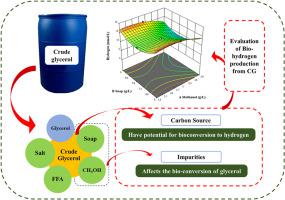当前位置:
X-MOL 学术
›
Biomass Bioenergy
›
论文详情
Our official English website, www.x-mol.net, welcomes your feedback! (Note: you will need to create a separate account there.)
Bio-hydrogen production from crude glycerol: Optimisation through response surface methodology and artificial neural network approach
Biomass & Bioenergy ( IF 5.8 ) Pub Date : 2024-05-17 , DOI: 10.1016/j.biombioe.2024.107243 Adarsha Kumar Pradhan , Hemant Goyal , Pushpraj Patel , Prasenjit Mondal
Biomass & Bioenergy ( IF 5.8 ) Pub Date : 2024-05-17 , DOI: 10.1016/j.biombioe.2024.107243 Adarsha Kumar Pradhan , Hemant Goyal , Pushpraj Patel , Prasenjit Mondal

|
Crude glycerol (CG) is the main by-product of biodiesel production from the transesterification of vegetable or animal oils. The CG's high energy content makes it an effective carbon source for bio-hydrogen production. However, the purity of CG derived from the transesterification process may vary due to impurities such as methanol, soap, salt, etc., which influence the hydrogen production yield. The present study investigated the impacts of initial glycerol, methanol, and soap concentration of CG on the hydrogen production by dark fermentation, and the effect of various factors was evaluated and optimised with the response surface methodology (RSM) and artificial neural network (ANN) approach to maximise the yield of hydrogen production. Both the results of these approaches showed good fitting. The correlation coefficient between actual and predicted values from RSM and ANN models is closer to ∼1, and the lower error shows the applicability of these models. A maximum of 17.67 mmol/L of hydrogen production was obtained via RSM with optimum methanol, soap and glycerol concentrations of 2.75 g/L, 6.07 g/L, and 20.45 g/L, respectively. Besides, the 3-D response surface graphs illustrated the suppressive impact of increased initial concentration of methanol and soap, along with higher initial concentrations of glycerol, on hydrogen production. Further, the outcome of the controlled experiment shows that the presence of impurities (methanol and soap) in glycerol reduces the cumulative hydrogen production by 5 %–17 % compared to the control for over five days.
中文翻译:

粗甘油生物制氢:通过响应面法和人工神经网络方法进行优化
粗甘油(CG)是植物油或动物油酯交换生产生物柴油的主要副产品。 CG的高能量含量使其成为生物制氢的有效碳源。然而,酯交换过程中产生的CG的纯度可能会因甲醇、肥皂、盐等杂质而变化,从而影响氢气的产率。本研究考察了CG的初始甘油、甲醇和皂浓度对暗发酵产氢的影响,并利用响应面法(RSM)和人工神经网络(ANN)评估和优化了各种因素的影响。最大限度地提高氢气产量的方法。这些方法的结果都显示出良好的拟合度。 RSM 和 ANN 模型的实际值与预测值之间的相关系数更接近~1,较低的误差表明了这些模型的适用性。在最佳甲醇、肥皂和甘油浓度分别为 2.75 g/L、6.07 g/L 和 20.45 g/L 的情况下,通过 RSM 获得了最大 17.67 mmol/L 的氢气产量。此外,3-D 响应曲面图说明了甲醇和肥皂初始浓度的增加以及甘油初始浓度的增加对氢气产生的抑制影响。此外,对照实验的结果表明,与对照相比,甘油中杂质(甲醇和肥皂)的存在超过五天,使累积氢气产量减少了 5%–17%。
更新日期:2024-05-17
中文翻译:

粗甘油生物制氢:通过响应面法和人工神经网络方法进行优化
粗甘油(CG)是植物油或动物油酯交换生产生物柴油的主要副产品。 CG的高能量含量使其成为生物制氢的有效碳源。然而,酯交换过程中产生的CG的纯度可能会因甲醇、肥皂、盐等杂质而变化,从而影响氢气的产率。本研究考察了CG的初始甘油、甲醇和皂浓度对暗发酵产氢的影响,并利用响应面法(RSM)和人工神经网络(ANN)评估和优化了各种因素的影响。最大限度地提高氢气产量的方法。这些方法的结果都显示出良好的拟合度。 RSM 和 ANN 模型的实际值与预测值之间的相关系数更接近~1,较低的误差表明了这些模型的适用性。在最佳甲醇、肥皂和甘油浓度分别为 2.75 g/L、6.07 g/L 和 20.45 g/L 的情况下,通过 RSM 获得了最大 17.67 mmol/L 的氢气产量。此外,3-D 响应曲面图说明了甲醇和肥皂初始浓度的增加以及甘油初始浓度的增加对氢气产生的抑制影响。此外,对照实验的结果表明,与对照相比,甘油中杂质(甲醇和肥皂)的存在超过五天,使累积氢气产量减少了 5%–17%。
















































 京公网安备 11010802027423号
京公网安备 11010802027423号